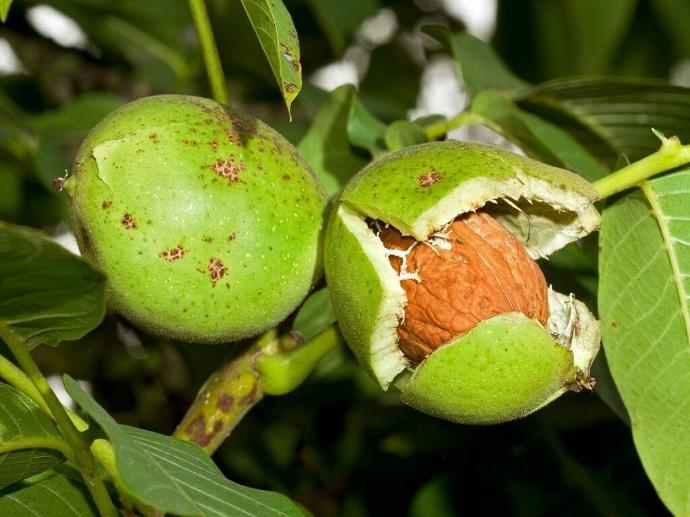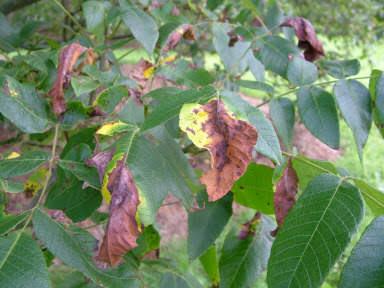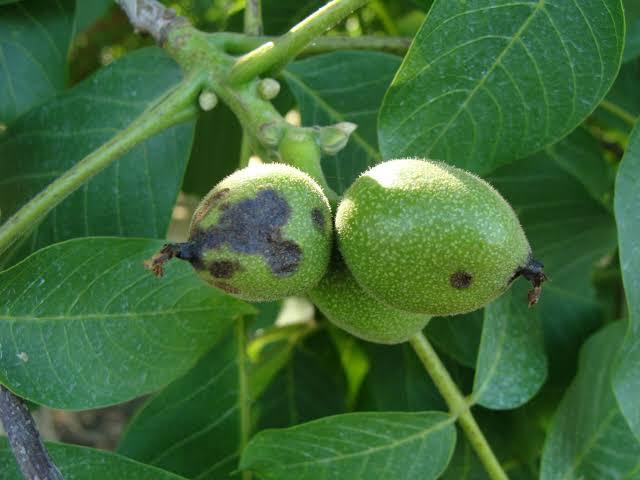Walnut Tree
Walnut trees, 30-60 feet tall in Zones 5-9, prefer well-drained soil and full sun for moderate growth. The nuts produced by walnut trees are edible and commonly used in cooking.

Habit
Tree
Height
8 to 12 m
Growth
Moderate
Soil
Well-drained, Sandy Loam
Shade
Full Sun
Moisture
Moderate
Edible
Yes
Medicinal
No
Origin
Europe, Asia
Climatic Condition
Temperate, Subtropical
Temperature (°)
15°C to 25°C
Humidity (%)
50% to 60%
Potting media
50% Loam, 40% Sand, 10% Organic Matter
Fertilizers
Organic Fertilizer
Watering
Regular watering
Plant Weight
15 to 30 kg
Flowering Time
Summer to Fall
Soil Ph level
6.0 to 7.5
Water Ph level
6.0 to 7.0
Soil EC
0.6 to 1.0 mS/cm
Yield Per Plant
100 to 200 kg per tree
NPK ratio
10:10:10
life Span
30 to 50 years
Health Benefits
High in Nutrients, Antioxidant
Suggested Grow Media or Potting Mix ?
50% loamy soil, 30% compost, 20% sand
Suggested Fertigation/Fertilizers
Fertilize every 4-6 weeks with a balanced fertilizer.
Common Diseases and Remedies
Walnut blight , Walnut leaf blotch
One to several black lesions may appear on catkins , Brown, roughly circular leaf spots.
Prune out and destroy infected tissues , collect and dispose the infected ones.
HEALTH BENEFITS
1. Rich in antioxidants: Walnuts contain antioxidants that can help protect against oxidative stress and inflammation.
2. May help support heart health: Walnuts' omega-3 fatty acid and antioxidant content may help support heart health.
3. May help regulate blood sugar: Walnuts' fiber and antioxidants may also help regulate blood sugar levels.
What Is An Walnut Tree?
A pecan plant regularly alludes to a tree that produces pecans. The pecan tree is known for its palatable nuts and is developed in different locales for its lumber and nuts.
The pecan plant, deductively known as Juglans regia, is a deciduous tree valued for its heavenly and nutritious nuts. Local to areas of Focal Asia, it's developed overall in mild environments. Pecan trees can grow up to 100 feet tall and have an expansive, spreading shade. The leaves are compound and organized on the other hand on the branches. Pecans foster inside a green husk, which ultimately parts open to uncover the hard shell encasing the consumable piece. These nuts are plentiful in omega-3 unsaturated fats, cell reinforcements, and minerals, making them a famous fixing in different culinary dishes and valued for their medical advantages.

What Are The Different Types Of Walnut Plants?
1. English Pecan (Juglans regia)
This is the most generally developed pecan species for its enormous, tasty nuts.
2. Dark Pecan (Juglans nigra)
Local to North America, known for its dim, delightful nuts and significant lumber.
3. Persian Pecan (Juglans regia 'Purpurea')
An assortment of English pecan with purple foliage.
4. Japanese Pecan (Juglans ailanthifolia)
Local to Japan, more modest in size contrasted with other pecan species.
5. Butternut (Juglans cinerea)
Otherwise called white pecan, local to North America, esteemed for its sweet nuts and fine-grained wood.

How to Care Walnut Plant ?
1. Location
Pecan plants flourish in calm environments with all around depleted soil and satisfactory daylight. They lean toward regions with cold winters for torpidity and warm summers for organic product advancement. In a perfect world, pecan plants ought to be established in areas with full sun openness and security from solid breezes. Districts with moderate precipitation or admittance to water system are advantageous for ideal development. Normal areas for developing pecan plants incorporate pieces of North America, Europe, Asia, and a few districts of Australia.
2. Sunshine
Pecan plants require full sun openness for ideal development and natural product creation. They flourish where they get no less than 6 to 8 hours of direct daylight everyday. Satisfactory daylight is fundamental for the plant's photosynthesis interaction, which is urgent for the improvement of leaves, blossoms, and nuts. Deficient daylight can prompt unfortunate development, decreased fruiting, and expanded weakness to sicknesses. Consequently, while establishing pecan trees, it's critical to pick a site that gets more than adequate daylight over the course of the day.
3. Soil
Pecan plants incline toward all around depleted, prolific soil for ideal development. They flourish in loamy soil with a pH level somewhere in the range of 6.0 and 7.5. Also, pecan trees favor soil that is wealthy in natural matter, for example, fertilizer or all around spoiled excrement, which holds dampness and gives fundamental supplements. While they can endure a scope of soil types, including sandy or clayey soils, great seepage is basic to forestall waterlogging, which can prompt root decay. Preceding planting, it's gainful to change the dirt with natural matter and guarantee legitimate seepage to establish an ideal developing climate for pecan plants.
4. Hydration
Pecan plants require normal watering, particularly during times of dynamic development and organic product improvement. Be that as it may, they are somewhat dry spell lenient once settled and can endure brief times of dryness. It's critical to keep up with steady soil dampness levels to forestall weight on the plants, especially during warm and dry climate. Profound watering, permitting the dirt to become damp a few inches down, is desirable over successive shallow watering, as it supports profound root development. Be that as it may, it's fundamental not to overwater, as exorbitant dampness can prompt root decay and other parasitic sicknesses. Observing soil dampness levels and changing watering recurrence in like manner is vital to guaranteeing the appropriate hydration of pecan plants
5. Nourishment
Pecan plants benefit from normal preparation to guarantee they get sufficient sustenance for sound development and organic product creation. A reasonable manure, like a 10-10-10 or comparative plan, can be applied in late-winter before new development starts and again in pre-summer or late-spring. Also, integrating natural matter into the dirt, like fertilizer or all around spoiled compost, gives fundamental supplements and further develops soil structure. It's critical to adhere to the maker's directions for application rates and timing to keep away from over-treatment, which can harm the plant and mischief the climate. Checking the plant's development and noticing any indications of supplement lack can assist with deciding the suitable preparation timetable and sort of manure to utilize.

6.Issues
Pecan trees are defenseless to different sicknesses, for example, pecan scourge, anthracnose, root decay, and thousand ulcers infection. These illnesses can cause leaf spots, shriveling, blisters, and generally decrease in tree wellbeing Pecan trees can be gone after by vermin, for example, pecan husk fly, pecan twig scarab, aphids, and bugs. These irritations can harm foliage, stems, and organic product, prompting decreased yield and quality.
1. *Nutritional value:* Pecans are a rich wellspring of omega-3 unsaturated fats, cell reinforcements, nutrients, and minerals, making them a nutritious expansion to a fair eating routine. They are related with further developed heart wellbeing, cerebrum capability, and generally speaking prosperity.
2. *Culinary versatility:* Pecans can be delighted in various culinary dishes, including servings of mixed greens, prepared products, sweets, and appetizing dishes. They add surface, flavor, and dietary benefit to feasts and tidbits.

FAQs About Growing Walnut
1.How to keep up with pecan plant?
Give ordinary watering, particularly during times of dry climate, to keep the dirt reliably damp yet not waterlogged. Profound watering is desirable over incessant shallow watering to empower profound root development.
2. What are the uses of walnut plants?
The primary use of walnut plants is for the production of edible nuts. Walnuts are consumed raw as snacks or added to a variety of culinary dishes, including salads, baked goods, desserts, and savory dishes.
3. Can I grow walnut plant indoor?
Walnut trees can grow quite large, reaching heights of up to 100 feet. Indoors, it's difficult to provide enough space for a walnut tree to reach its full size.
4. Which pot is best for growing walnut plant?
Select a pot that is large enough to accommodate the walnut plant's root system and allow for future growth. A container with a diameter of at least 24 to 36 inches and a depth of 18 to 24 inches is suitable for a young walnut tree.
5. From where can I shop walnut plant ?
Local nurseries and garden centers often carry a selection of walnut plants, including young saplings or potted trees. Visit your nearest nursery to see what varieties are available and get advice from knowledgeable staff.

